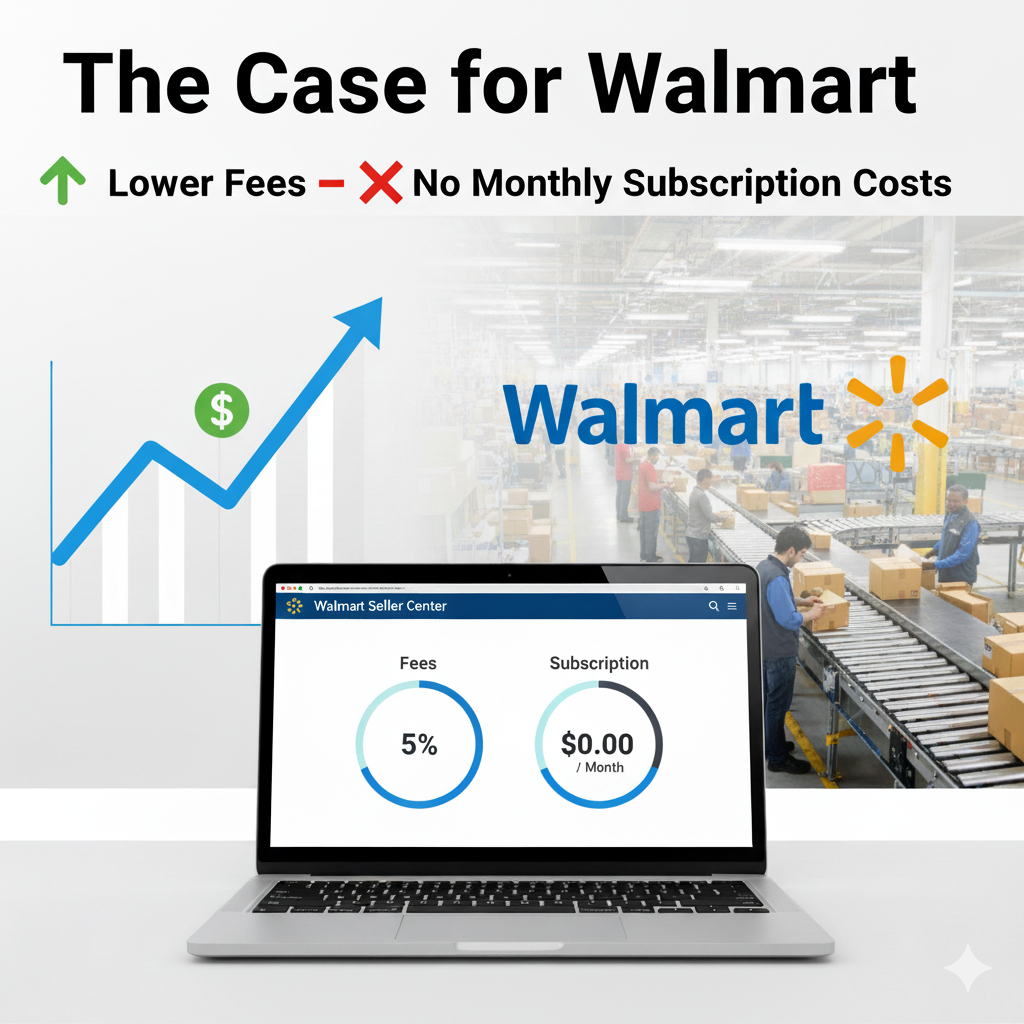This is the compelling case for Walmart. As a dominant force in retail, Walmart offers an incredible opportunity for marketplace sellers, particularly those leveraging powerful tools like Quixess for all-in-one e-commerce management.
Many sellers are waking up to the realization that Amazon is not the only game in town. In fact, many are finding that their current platform is unnecessarily complicated and expensive.
Is your current marketplace really giving you the return you deserve, or is it silently draining your capital month after month?
Are you tired of watching your hard-earned profits vanish into a black hole of e-commerce fees and recurring monthly subscriptions? Every seller has faced this frustrating reality: the bigger your sales, the bigger the bite taken by platform overhead.
It feels like you’re running a successful business just to keep feeding the giant.
But what if there was a better, more cost-effective path for growth? A path where lower fees and the absence of hefty subscription costs fundamentally changed your bottom line?
The Hidden Costs: A Tale of Two Marketplaces
When you first start an online Walmart business or any other major platform, the appeal of instant access to millions of customers is powerful.
However, the true cost of operating quickly becomes apparent, often hidden in complex fee structures.
The Competitor’s Model: Fees and Financial Pressure
Consider the typical charges on some competing platforms: they often include a professional selling fee, which is a fixed monthly cost regardless of your sales volume.
Even on a slow month, you are still on the hook for that fee. This structure imposes a fixed financial burden that new or smaller sellers must overcome just to break even.
On top of this, you pay a referral fee, sometimes known as a commission, on every single sale.
This combination can create a significant drag on profitability, forcing sellers to constantly chase volume to justify their fixed expense.
Walmart’s Advantage: Simplicity and Lower Barrier to Entry
Walmart flips this script, offering a markedly simpler and more seller-friendly fee structure. Crucially, Walmart does not charge a mandatory monthly subscription fee to be a third-party seller.
Think about the immediate, positive impact this has on a seller, especially a new one or someone who deals with seasonal sales fluctuations.
If you have a slow January, that monthly fee you are not paying directly increases your profit margin for that month.
This structural difference offers a powerful safety net and a fundamental advantage for small to medium-sized businesses looking to scale without oppressive financial obligations.
By eliminating the fixed monthly fee and relying solely on a competitive referral fee (commission) per sale, Walmart essentially ensures that the platform only profits when the seller profits.
This alignment of incentives makes it easier for entrepreneurs to test new products, manage inventory through off-peak periods, and sustain operations with lower overhead, ultimately fostering a more vibrant and diverse marketplace ecosystem.
Data Deep Dive: Where Walmart’s Fees Truly Shine
Let’s look at the numbers. On a major competitor, referral fees can vary widely and often include additional per-item closing fees, with rates generally ranging between 6% and 45% of the sale price.
Now, let’s consider Walmart. Its referral fees are highly competitive and transparent, typically ranging between 5% and 20% across most major categories, signaling a clear commitment to seller profitability.
The Financial Impact: A Hypothetical Case Study
This difference becomes dramatically clear when looking at the total cost structure.
For example, imagine you sell a consumer electronics item for $100.
On a competing platform, a 15% referral fee plus a $39.99 monthly subscription fee is common for the professional seller tier.
- Competing Platform Cost: $15.00 (15% referral fee) + $39.99 (fixed monthly subscription) = $54.99 Total Fees
- Walmart Marketplace Cost: $15.00 (15% referral fee) + $0.00 (no fixed monthly fee) = $15.00 Total Fees
In this single-sale scenario, you have just saved $39.99, which represents a massive 72% reduction in total platform cost for that month!
This immediate and significant saving, compounded over dozens or hundreds of slow-moving or seasonal products, makes the Walmart marketplace a compelling, low-risk choice for any business aiming for sustainable growth.
Are high fees holding your business back and silently eroding your profit margins? Stop losing profit to unnecessary, fixed monthly costs.
Take the next step to financial freedom on the world’s fastest-growing marketplace.
Join Quixess Beta free guide, to maximizing profit on Walmart, and to learn how to seamlessly transition your inventory and automate your sales with a centralized marketplace management system.
Click the button to finally take control of your e-commerce costs and unlock your full profit potential!
Beyond the Fees: The Automation and Support Ecosystem
It’s not just about money; it is also about efficiency, scalability, and robust support. A successful e-commerce business thrives on streamlined operations.
Managing inventory, dynamic pricing, and complex fulfillment across multiple channels—often called centralized marketplace management—requires robust, integrated software.
The Power of Automation
This is where the power of tools built for Walmart dropshipping and general seller automation comes into play.
These systems ensure that you can manage your entire operational workflow smoothly without getting tangled in complex, platform-specific rules.
Automation minimizes human error, ensures inventory sync is real-time, and guarantees that pricing adjustments remain competitive, which is critical for winning the Buy Box.
By integrating third-party tools, sellers can treat Walmart as a central, efficient node in their multi-channel strategy, moving beyond manual tasks to focus on strategic growth.
Crucial Seller Support
Furthermore, accessible and effective Walmart customer service for sellers is crucial for long-term confidence.
While all major platforms have their operational challenges, the focus on seller success at Walmart is evident in their streamlined onboarding and support processes.
New sellers often find the path to listing products, managing their Walmart delivery and logistics, and understanding compliance requirements more straightforward.
This ease of entry, combined with the lack of financial penalty for a slow start (i.e., no mandatory monthly fee), makes it a lower-risk, highly appealing environment for expansion and diversification.
This comprehensive ecosystem of automated tools and supportive platform policies ensures that sellers can operate efficiently, resolve issues quickly, and scale their businesses confidently.
The Role of Customer Support in Marketplace Success
Excellent Walmart customer service is more than just answering tickets; it is about building a foundation of trust and loyalty.
Understanding what is the role of customer support in marketplaces? The answer is simple: it is the critical bridge between the buyer, the seller, and the platform.
For the Customer: The Engine of Retention
When a customer needs assistance with tracking their order or has a question about a product, prompt, empathetic, and accurate support ensures a positive experience and drives repeat business and brand advocacy.
A seamless and helpful interaction transforms a potential point of frustration—like a delayed delivery or a defective item—into an opportunity to delight the customer.
This level of care significantly reduces cart abandonment, minimizes negative reviews, and cultivates a sense of security that makes customers feel safe returning to the platform for future purchases.
In the high-stakes world of e-commerce, support is a powerful differentiator that goes beyond competitive pricing.
For the Seller: Enabling Growth and Efficiency
For sellers, access to reliable support for technical issues, payout questions, or policy clarification is absolutely invaluable.
A strong support system acts as a shield against complexity.
Walmart’s commitment to improving its seller support ecosystem, especially as it rapidly grows its third-party seller count, is a clear signal of its investment in the marketplace’s future.
This focus on robust backend infrastructure and clear, accessible policies directly helps sellers minimize costly errors and maximize operational efficiency, freeing them up to focus on what truly matters: product sourcing, strategic growth, and delivering excellent value to their own customers.
Furthermore, effective support helps sellers quickly resolve disputes and maintain a high performance rating, which is essential for visibility and success on the platform.
Conclusion
Ultimately, by prioritizing both buyer and seller support, a marketplace like Walmart establishes itself as a reliable, fair, and user-friendly environment, leading to a virtuous cycle of increased transactions and sustained growth for all parties involved.
Ready to move past expensive monthly subscriptions and complicated fee structures? The future of profitable e-commerce is on Walmart.
Contact Quixess today for a personalized demonstration of our all-in-one e-commerce solution and start maximizing your profit tomorrow.


